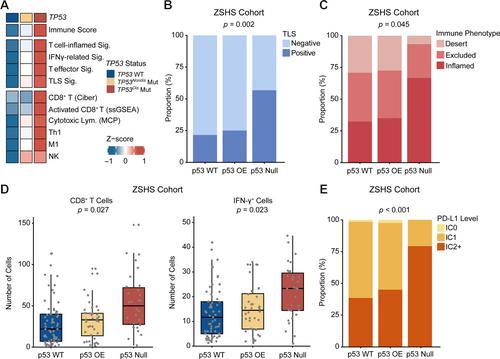Kaifeng Jin, Jingtong Xu, Xiaohe Su, Ziyue Xu, Bingyu Li, Ge Liu, Hailong Liu, Yiwei Wang, Yu Zhu, Le Xu, Weijuan Zhang, Zhaopei Liu, Zewei Wang, Yuan Chang, Jiejie Xu
下载PDF
{"title":"TP53破坏性突变可预测铂类化疗和PD-1/PD-L1阻断剂对尿路上皮癌的反应。","authors":"Kaifeng Jin, Jingtong Xu, Xiaohe Su, Ziyue Xu, Bingyu Li, Ge Liu, Hailong Liu, Yiwei Wang, Yu Zhu, Le Xu, Weijuan Zhang, Zhaopei Liu, Zewei Wang, Yuan Chang, Jiejie Xu","doi":"10.1002/path.6266","DOIUrl":null,"url":null,"abstract":"<p><i>TP53</i> mutation is one of the most common genetic alterations in urothelial carcinoma (UrCa), and heterogeneity of <i>TP53</i> mutants leads to heterogeneous clinical outcomes. This study aimed to investigate the clinical relevance of specific <i>TP53</i> mutations in UrCa. In this study, a total of eight cohorts were enrolled, along with matched clinical annotation. <i>TP53</i> mutations were classified as disruptive and nondisruptive according to the degree of disturbance of p53 protein function and structure. We evaluated the clinical significance of <i>TP53</i> mutations in our local datasets and publicly available datasets. The co-occurring events of <i>TP53</i> mutations in UrCa, along with their therapeutic indications, functional effects, and the tumor immune microenvironment, were also investigated. <i>TP53</i> mutations were identified in 49.7% of the UrCa patients. Within this group, 25.1% of patients carried <i>TP53</i><sup>Disruptive</sup> mutations, a genetic alteration correlated with a significantly poorer overall survival (OS) when compared to individuals with <i>TP53</i><sup>Nondisruptive</sup> mutations and those with wild-type <i>TP53</i>. Significantly, patients with <i>TP53</i><sup>Disruptive</sup> mutations exhibit an increased probability of responding favorably to PD-1/PD-L1 blockade and chemoimmunotherapy. Meanwhile, there was no noteworthy distinction in OS among patients with varying <i>TP53</i> mutation status who underwent chemotherapy. Samples with <i>TP53</i><sup>Disruptive</sup> mutations showed an enriched APOBEC- and POLE-related mutational signature, as well as an elevated tumor mutation burden. The sensitivity to immunotherapy in tumors carrying <i>TP53</i><sup>Disruptive</sup> mutation may be attributed to the inflamed tumor microenvironment characterized by increased CD8<sup>+</sup>T cell infiltration and interferon-gamma signaling activation. In conclusion, UrCa patients with <i>TP53</i><sup>Disruptive</sup> mutations have shown reduced survival rates, yet they may respond well to PD-1/PD-L1 blockade therapy and chemoimmunotherapy. By distinguishing specific <i>TP53</i> mutations, we can improve risk stratification and offer personalized genomics-guided therapy to UrCa patients. © 2024 The Authors. <i>The Journal of Pathology</i> published by John Wiley & Sons Ltd on behalf of The Pathological Society of Great Britain and Ireland.</p>","PeriodicalId":232,"journal":{"name":"The Journal of Pathology","volume":"263 2","pages":"139-149"},"PeriodicalIF":5.6000,"publicationDate":"2024-02-21","publicationTypes":"Journal Article","fieldsOfStudy":null,"isOpenAccess":false,"openAccessPdf":"https://onlinelibrary.wiley.com/doi/epdf/10.1002/path.6266","citationCount":"0","resultStr":"{\"title\":\"TP53 disruptive mutation predicts platinum-based chemotherapy and PD-1/PD-L1 blockade response in urothelial carcinoma\",\"authors\":\"Kaifeng Jin, Jingtong Xu, Xiaohe Su, Ziyue Xu, Bingyu Li, Ge Liu, Hailong Liu, Yiwei Wang, Yu Zhu, Le Xu, Weijuan Zhang, Zhaopei Liu, Zewei Wang, Yuan Chang, Jiejie Xu\",\"doi\":\"10.1002/path.6266\",\"DOIUrl\":null,\"url\":null,\"abstract\":\"<p><i>TP53</i> mutation is one of the most common genetic alterations in urothelial carcinoma (UrCa), and heterogeneity of <i>TP53</i> mutants leads to heterogeneous clinical outcomes. This study aimed to investigate the clinical relevance of specific <i>TP53</i> mutations in UrCa. In this study, a total of eight cohorts were enrolled, along with matched clinical annotation. <i>TP53</i> mutations were classified as disruptive and nondisruptive according to the degree of disturbance of p53 protein function and structure. We evaluated the clinical significance of <i>TP53</i> mutations in our local datasets and publicly available datasets. The co-occurring events of <i>TP53</i> mutations in UrCa, along with their therapeutic indications, functional effects, and the tumor immune microenvironment, were also investigated. <i>TP53</i> mutations were identified in 49.7% of the UrCa patients. Within this group, 25.1% of patients carried <i>TP53</i><sup>Disruptive</sup> mutations, a genetic alteration correlated with a significantly poorer overall survival (OS) when compared to individuals with <i>TP53</i><sup>Nondisruptive</sup> mutations and those with wild-type <i>TP53</i>. Significantly, patients with <i>TP53</i><sup>Disruptive</sup> mutations exhibit an increased probability of responding favorably to PD-1/PD-L1 blockade and chemoimmunotherapy. Meanwhile, there was no noteworthy distinction in OS among patients with varying <i>TP53</i> mutation status who underwent chemotherapy. Samples with <i>TP53</i><sup>Disruptive</sup> mutations showed an enriched APOBEC- and POLE-related mutational signature, as well as an elevated tumor mutation burden. The sensitivity to immunotherapy in tumors carrying <i>TP53</i><sup>Disruptive</sup> mutation may be attributed to the inflamed tumor microenvironment characterized by increased CD8<sup>+</sup>T cell infiltration and interferon-gamma signaling activation. In conclusion, UrCa patients with <i>TP53</i><sup>Disruptive</sup> mutations have shown reduced survival rates, yet they may respond well to PD-1/PD-L1 blockade therapy and chemoimmunotherapy. By distinguishing specific <i>TP53</i> mutations, we can improve risk stratification and offer personalized genomics-guided therapy to UrCa patients. © 2024 The Authors. <i>The Journal of Pathology</i> published by John Wiley & Sons Ltd on behalf of The Pathological Society of Great Britain and Ireland.</p>\",\"PeriodicalId\":232,\"journal\":{\"name\":\"The Journal of Pathology\",\"volume\":\"263 2\",\"pages\":\"139-149\"},\"PeriodicalIF\":5.6000,\"publicationDate\":\"2024-02-21\",\"publicationTypes\":\"Journal Article\",\"fieldsOfStudy\":null,\"isOpenAccess\":false,\"openAccessPdf\":\"https://onlinelibrary.wiley.com/doi/epdf/10.1002/path.6266\",\"citationCount\":\"0\",\"resultStr\":null,\"platform\":\"Semanticscholar\",\"paperid\":null,\"PeriodicalName\":\"The Journal of Pathology\",\"FirstCategoryId\":\"3\",\"ListUrlMain\":\"https://onlinelibrary.wiley.com/doi/10.1002/path.6266\",\"RegionNum\":2,\"RegionCategory\":\"医学\",\"ArticlePicture\":[],\"TitleCN\":null,\"AbstractTextCN\":null,\"PMCID\":null,\"EPubDate\":\"\",\"PubModel\":\"\",\"JCR\":\"Q1\",\"JCRName\":\"ONCOLOGY\",\"Score\":null,\"Total\":0}","platform":"Semanticscholar","paperid":null,"PeriodicalName":"The Journal of Pathology","FirstCategoryId":"3","ListUrlMain":"https://onlinelibrary.wiley.com/doi/10.1002/path.6266","RegionNum":2,"RegionCategory":"医学","ArticlePicture":[],"TitleCN":null,"AbstractTextCN":null,"PMCID":null,"EPubDate":"","PubModel":"","JCR":"Q1","JCRName":"ONCOLOGY","Score":null,"Total":0}
引用次数: 0
引用
批量引用


 求助内容:
求助内容: 应助结果提醒方式:
应助结果提醒方式:


